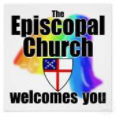
- We are members of the Episcopal Church, a denomination striving imperfectly and sincerely to offer Jesus’ radical hospitality to all.
- We celebrate and affirm people of all sexualities and all genders, and we welcome them in all areas of our life together: worshiping in our pews, getting married in our church, participating in our ministries and serving as lay leaders, staff, and clergy.
- Jesus taught love of God and love of neighbor as the most important commandments. When we create a safe environment for everyone, we honor His teaching.
Here’s what to expect…
Sunday is traditionally when Episcopalians gather for worship. The principal weekly worship service is the Holy Eucharist, also known as: the Lord’s Supper, Holy Communion, or Mass. In St. Mark’s worship is accompanied by the singing of hymns.
Worship Styles
All worship in the Episcopal Church is based in the Book of Common Prayer, which gives worship a familiar feel, no matter where you go. Episcopalians worship in many different styles, ranging from very formal, ancient, and multi-sensory rites with lots of singing, music, fancy clothes (called vestments), and incense, to informal services with contemporary music. St. Mark’s service is very informal. You can come in your Sunday best or in your everyday clothes. We are just appreciative that you wish to spend the time to worship with us.
Liturgy and Ritual
Worship in the Episcopal Church is said to be “liturgical,” meaning that the congregation follows service forms and prays from texts that don’t change greatly from week to week during a season of the year. This sameness from week to week gives worship a rhythm that becomes comforting and familiar to the worshipers.
The Holy Eucharist
In spite of the diversity of worship styles in the Episcopal Church, Holy Eucharist always has the same components and the same shape.
The Liturgy of the Word
We begin by praising God through song and prayer, and then listen to as many as four readings from the Bible. Usually one from the Old Testament, a Psalm, something from the Epistles or Letters, and (always) a reading from the Gospels. The psalm is usually recited by the congregation.
Next, a sermon interpreting the readings appointed for the day is preached followed by reciting the Nicene Creed.
After the sermon, the congregation prays together—for the Church, the World, and those in need followed by the confession in which we are assured that God is always ready to forgive our sins. Finally, the congregation greets one another with a sign of “peace.”
The Liturgy of the Table
Next, our priest stands at the table, which has been set with a cup of wine and a plate of bread or wafers, raises her hands, and greets the congregation again, saying “The Lord be With You.” Now begins the Eucharistic Prayer followed by the story of the coming of Jesus Christ. The presider blesses the bread and wine, and the congregation recites the Lord’s Prayer. Finally, the presider breaks the bread and offers it to the congregation, as the “gifts of God for the People of God.” The congregation then shares the consecrated bread and the wine.
The congregation lines up and receives the bread (wafer) and can partake of the wine by sipping from the common cup or by intinction (dipping of the wafer). Many parishioners choose to just receive the bread or if you are not comfortable receiving communion, you may just continue to sit in your pew.
At the end of the Eucharist, the congregation prays once more in thanksgiving, and then is dismissed to continue the life of service to God and to the World. The entire service typically lasts 45 minutes to one hour.
——————–
Learn all about the Episcopal Church’s Liturgy and Music
(Click below)
